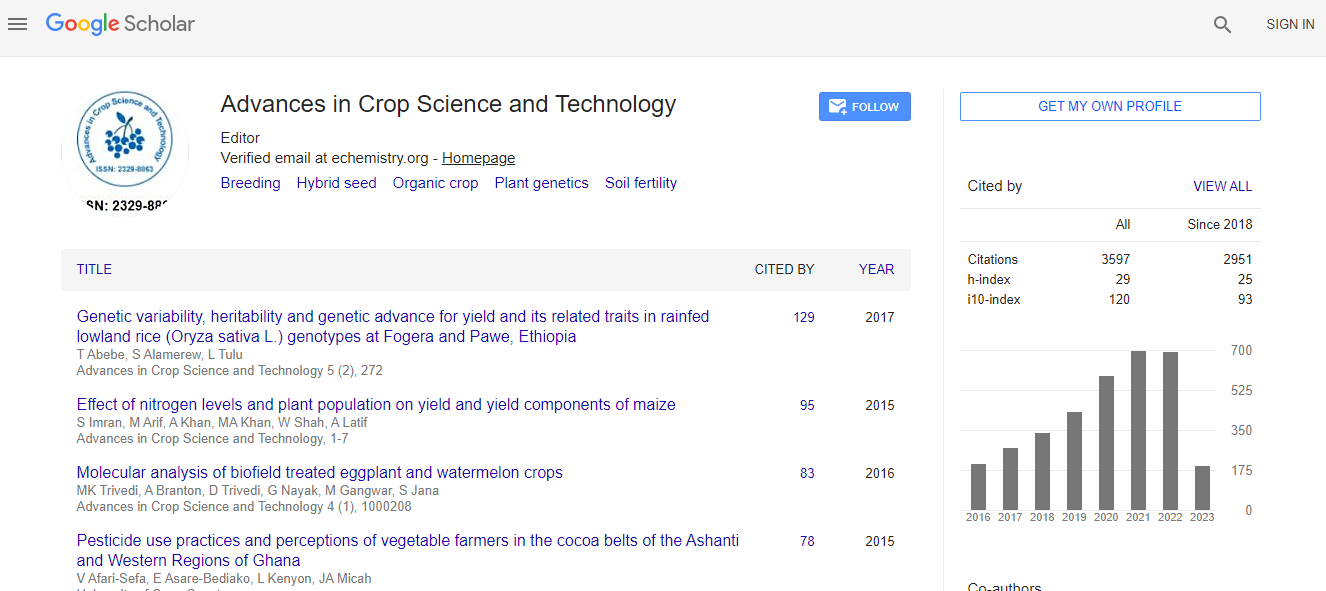Our Group organises 3000+ Global Conferenceseries Events every year across USA, Europe & Asia with support from 1000 more scientific Societies and Publishes 700+ Open Access Journals which contains over 50000 eminent personalities, reputed scientists as editorial board members.
Open Access Journals gaining more Readers and Citations
700 Journals and 15,000,000 Readers Each Journal is getting 25,000+ Readers
Google Scholar citation report
Citations : 5759
Advances in Crop Science and Technology received 5759 citations as per Google Scholar report
Advances in Crop Science and Technology peer review process verified at publons
Indexed In
- CAS Source Index (CASSI)
- Index Copernicus
- Google Scholar
- Sherpa Romeo
- Online Access to Research in the Environment (OARE)
- Open J Gate
- Academic Keys
- JournalTOCs
- Access to Global Online Research in Agriculture (AGORA)
- RefSeek
- Hamdard University
- EBSCO A-Z
- OCLC- WorldCat
- Scholarsteer
- SWB online catalog
- Publons
- Euro Pub
Useful Links
Recommended Journals
Related Subjects
Share This Page
Phylogenic analysis of genera Bellevalia, Leopoldia, Muscari and Pseudomuscari species (Hyacinthaceae) in Iran based on four plastid DNA regions
4th International Conference on Plant Genomics
Azarnoosh Jafari, Jamil Vaezi, Mohammad Mahdi Forghanifard, Mohammad Farsi, Maryam Behroozian and Felix Forest
Islamic Azad University, Mashhad, IranFerdowsi university of Mashhad, Mashhad, IranDamghan Branch, Islamic Azad University, Damghan, IranFerdowsi university of Mashhad, Mashhad, IranRoyal Botanic Gardens, Kew, UK
ScientificTracks Abstracts: Adv Crop Sci Tech
Abstract
In the present research, a phylogenetic study of the Iranian species of Bellevalia, Leopoldia, Muscari and Pseudomuscari (tribe Hyacinthaceae, Asparagaceae) was performed based on the plastid regions rbcL, matK, trnL intron and trnL-F spacer. The four sections of genus Bellevalia i.e. Nutans, Patens, Conica and Oxydonta are found in Iran. Traditionally, flower colour and shape, the ratio of leaf to scape length were used to delimit sections, subsections and species, while an overlap in these features was sometime observed and flower color and shape change in fresh and dried specimen. Regarding Muscari, Davis and Stuart believed that Pseudomuscari and Leopoldia were subgenera of this genus while Garbari and Greuter treated them as distinct genera. These three genera are distinguished based on flower color, shape and throat contraction. Leopoldia is similar to Bellevalia and Muscari is similar to Pseudomuscari. So, in order to determine the exact circumscription of sections and genera, a phylogenetic analysis based on four plastid DNA regions was performed. For this 91 specimens including Hyacinthus as out group taxon were evaluated. The results showed that Bellevalia is a monophyletic clade but that its sections are not. Also, some Leopoldia species are placed in the Muscari clade. Moreover the two possible positions of Muscari and Leopoldia shown here can be explained by hybridization between these two genera. Thus, based on these results, Leopoldia could be considered as an infrageneric rank of Muscari. Since, no decisive point was observed in genera and sections circumscription, it is recommended that this molecular analysis is expanded to investigate further the relationships among species of Hyacinthaceae in Iran.Biography
Azarnoosh Jafari has completed her PhD in 2004 from Research and Sciences of Tehran Branch, Islamic Azad University. She is the Director of the project and she has published more than 50 papers in English and Persian.
E-mail: Azarnoosh_djafari@mshdiau.ac.ir

 Spanish
Spanish  Chinese
Chinese  Russian
Russian  German
German  French
French  Japanese
Japanese  Portuguese
Portuguese  Hindi
Hindi 
